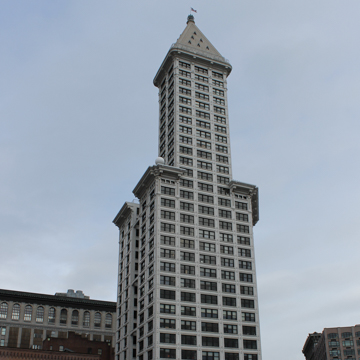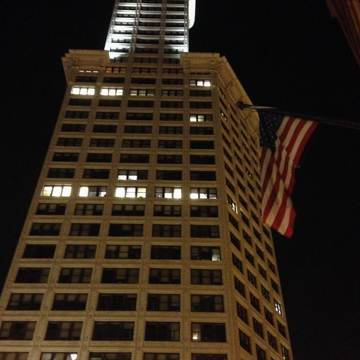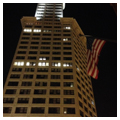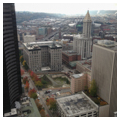You are here
Smith Tower
Leading up to July 4, 1914, advertisements in Seattle’s newspapers proliferated in advance of the grand opening of the new L.C. Smith Building on Second Avenue and Yesler Way in the heart of Pioneer Square. Underscoring the importance of what was set to become the tallest building west of the Mississippi, one full-page advertisement declared, “The 42-story L.C. Smith Building typifies Seattle spirit and growth.” While skeptics have since debunked the myth that the approximately $1.5 million building contained 42 floors at its opening (the number was actually closer to 36), the notion that the Smith Tower served as a symbol for the city’s progress and prosperity has rarely been a point of contention.
What was promoted as the “highest, finest, and most complete office building in the world outside of New York City” came equipped with several up-to-date amenities including a wireless telegraph, telephones, eight high-speed elevators, and a central vacuum system with “plug-ins” in every office. The building featured retail at the base with offices above, as well as a public, open-air observation deck on the 35th floor extending from what was advertised as a “Japanese Tea Room” but designed loosely following the manner of a Chinese temple with a carved teak ceiling and blackwood furniture. For much of the twentieth century, the 462-foot-tall skyscraper, with its distinctive pyramidal roof, more than 2,300 bronze-encased windows, and over 1,400 steel doors was a regular feature on postcards and other images promoting the city of Seattle, and held the title of the city’s tallest structure for nearly 50 years. It was also the tallest building west of the Rocky Mountains during this period.
The Smith Tower was designed by the Syracuse, New York–based architectural firm Gaggin and Gaggin, whose prior experience did not include any building more than five stories tall. Yet the firm was known to the tower’s developer, Lyman Cornelius (L.C.) Smith, who had made a fortune in the typewriter and gun manufacturing industries and also hailed from Syracuse. To provide the building with architectural distinction, Gaggin and Gaggin (founded by the brothers Edward Gaggin and T. Walker Gaggin) specified what was essentially a two-tower form, with a thin, 11-story tower with a pyramidal cap mounted atop a blockier, 24-story base with a cornice—a form that had begun to grace the New York skyline but was unknown in the western United States. To help set it apart from the predominantly brick-and-stone buildings that marked the buildings of surrounding Pioneer Square, the architects gave the tower a predominantly white terra-cotta exterior that rose above a two-story base made of local granite. A decorative masonry balustrade also wrapped around the base of the pyramidal cap, each side of which featured 6 pointed-arch window openings. An 8-foot glass globe was perched at the cap’s pinnacle, serving as a beacon to ships in the Puget Sound.
The Smith Tower began construction in November 1911 when the E.E. Davis Company of Seattle began assembling a 7.97-million-pound fireproof steel frame, which was reinforced by 50 concrete support columns. Yet much of the building hailed from outside the city and state: the steel was manufactured by the American Bridge Company of Pittsburgh, Pennsylvania, and the terra-cotta cladding came from California. In addition, the general contractor and structural engineer were based in New York City. The various designers worked to make the Smith Tower a prime office building, with an elaborate, high-ceilinged lobby with polished marble walls and ornate decorations.
The tower’s height and design were sparked by a friendly competition between L.C. Smith and developer John Hoge for bragging rights to Seattle’s tallest and most extravagant skyscraper. As plans for the Smith Tower were being developed, construction had begun for the nearby 18-story, 205-foot-tall Hoge Building, designed by Bebb and Mendel in a Renaissance Revival style. Determined not to be outdone by Hoge, Smith made preparations for the slender, capped tower to spring from the west edge of his skyscraper, thereby extending the Smith Tower to nearly twice the height of the Hoge Building and permitting it to broadly resemble distinctive contemporary skyscrapers in New York. Smith justified the tower extension by noting the advertising boost that the Singer Building, the Metropolitan Life Insurance Company Tower, and the Woolworth Building (then under construction) brought to their respective business empires and the city of New York, and wished the design and height of his skyscraper to have a similar effect for his business—and the city of Seattle. He was willing to pay what was necessary to ensure that his tower would become “…a monumental advertisement for Seattle and the Northwest.”
The Smith Tower’s design, however, did not meet universal approval. Its “mounted” form deviated from the more typical single-volume skyscraper design and its white, terra-cotta exterior offered a marked contrast to the Richardsonian Romanesque buildings that characterized several other Pioneer Square buildings erected in the wake of the Great Seattle Fire of 1889. Furthermore, plans for the Smith Tower sparked a highly publicized and contentious debate between the building’s East Coast financier and Seattle officials who wished to scale back plans for the tall building that seemed, to Seattle locals, more appropriate for New York City.
The tower was also something of a peculiar investment for Smith, who had spent little time in the Pacific Northwest. Buoyed by the economic optimism generated by post-fire reconstruction, however, in the 1890s Smith purchased several properties and land in the Pioneer Square area just south of Yesler Way from local developer J.W. Clise—site unseen. Smith apparently speculated that the filling in and raising of street levels by 22 feet as well as new building codes that stipulated brick or stone for new construction in the area also provided favorable economic conditions. The land upon which the Smith Tower would eventually be erected was thus lifted out of the “boggy, marshy ground,” and the prosperity that came to Seattle following the Klondike Gold Rush in 1897 made the area ripe for further development.
It was not until 1909 that Lyman Smith finally paid a visit to Seattle and his Pioneer Square properties. By that time, the city’s business core had begun moving to the north along Second Avenue, and Pioneer Square was becoming what the Seattle Department of Neighborhoods described as a “honky-tonk district of taverns, entertainment houses, and bawdy hotels.” Nonetheless, Clise encouraged Smith to improve his property at Second Avenue and Yesler Way. Smith passed away in 1910, but his son, Burns, personally saw to it that his father’s structure would be completed, and that it would extend higher than the Hoge Building.
Although height limits restricted buildings to 208 feet in Seattle at the time, Burns Smith was adamant that the new tower reach 42 stories to ensure that no building would encroach upon its height in his lifetime. This put Burns Smith and Clise at odds with city ordinances. The city superintendent of buildings, Francis W. Grant, initially refused to issue a building permit, expressing concern about making “certain concessions…in accordance with the practice in the building departments of large Eastern cities,” and insisting that the building must “adhere to the regulations of the present building ordinances [in Seattle].” But public outcry at the prospect of losing a massive business investment tipped the scales in the Smith Estate’s favor when Mayor Hiram C. Gill signed a building variance that authorized for the construction of the L.C. Smith Building to begin later that year.
It is not, however, clear that Smith’s venture ever yielded a profit, and only 10 years after its 1914 completion it was sold to new owners. Over the course of the twentieth century, the building changed hands several more time but experienced few alterations—save for the removal of the balustrade at the base of the pyramidal cap at some point in the 1970s, a general renovation in 1986, and the 1990 conversion of the space in the pyramidal cap from a water tank into a 3-story penthouse apartment. In 2000, however, Seattle-based architect Mithun completed a substantial renovation of the tower following its purchase by the Samis Foundation. The work included a seismic upgrade, new interior and exterior lighting, new entrances and storefronts, accessible restrooms, the addition of a fitness center in the basement, and refurbished elevators—still with their lattice doors and brass cages operated by elevator attendants. The “Chinese Room” was closed permanently in 2014 and transformed into a Prohibition-themed restaurant following the building’s purchase by Unico Properties LLC.
References
Bagley, Clarence B. “Syracuse’s Mark on Seattle: The LC Smith Tower.” In History of Seattle: From the Earliest Settlement to the Present Time. Chicago: The SJ Clarke Publishing Company, 1916.
Crowley, Walt, and Patrick McRoberts. “Seattle Neighborhoods: Downtown Seattle—Thumbnail History.” Essay 1041. HistoryLink.org: The Free Online Encyclopedia of Washington State History, April 17, 1999. Accessed December 8, 2016. www.historylink.org.
Enlow, Claire. “Lofty Ambitions: Seattle’s Highrise Builders.” Seattle Daily Journal of Commerce, April 24, 1997.
Enlow, Claire. “New Life for a Landmark: Smith Tower Ready for Another Century.” Seattle Daily Journal of Commerce, January 5, 2000.
“How Syracuse Built the World’s Tallest Skyscraper Outside of New York City, In Seattle.” Syracuse Then and Now. Accessed October 20, 2015. http://syracusethenandnow.org/.
Long, Priscilla. “Clise, James (1855-1939).” Essay 1688. HistoryLink.org: The Free Online Encyclopedia of Washington State History, September 27, 1999. Accessed December 7, 2016. www.historylink.org.
“Lyman C. Smith Dead.” New York Times, November 6, 1910.
Mattison, M.M. “Friends Wire Gill Message of Good Will.” Seattle Times, March 5, 1914.
Morse, Kathryn. “The Klondike Gold Rush.” Center for the Study of the Pacific Northwest. Accessed December 8, 2016. http://www.washington.edu/.
Pastier, John. “Smith Tower (Seattle).” Essay 4310. HistoryLink.org: The Free Online Encyclopedia of Washington State History, July 1, 2004. Accessed October 19, 2015. www.historylink.org.
“Pioneer Square.” City of Seattle, Seattle Department of Neighborhoods. Seattle.gov. Accessed December 8, 2016. http://www.seattle.gov/.
“Pioneer Square-Skid Row National Historic District,” King County, Washington. National Register of Historic Places Inventory-Nomination Form, 2007. National Park Service, U.S. Department of the Interior, Washington, D.C.
“Seattle is Your Success.” Seattle Times, July 2, 1914.
“Smith Building Jeopardized by Grant’s Action.” Seattle Times, February 19, 1911.
“Smith Tower.” Historic Property Inventory Report, Field Site No. 117. State Department of Archaeology and Historic Preservation, Washington.
Writing Credits
If SAH Archipedia has been useful to you, please consider supporting it.
SAH Archipedia tells the story of the United States through its buildings, landscapes, and cities. This freely available resource empowers the public with authoritative knowledge that deepens their understanding and appreciation of the built environment. But the Society of Architectural Historians, which created SAH Archipedia with University of Virginia Press, needs your support to maintain the high-caliber research, writing, photography, cartography, editing, design, and programming that make SAH Archipedia a trusted online resource available to all who value the history of place, heritage tourism, and learning.



















